| کد مقاله | کد نشریه | سال انتشار | مقاله انگلیسی | نسخه تمام متن |
|---|---|---|---|---|
| 6432991 | 1635500 | 2011 | 12 صفحه PDF | دانلود رایگان |

Along coasts and estuaries, formerly embanked land is increasingly restored into tidal marshes in order to re-establish valuable ecosystem services, such as buffering against flooding. Along the Scheldt estuary (Belgium), tidal marshes are restored on embanked land by allowing a controlled reduced tide (CRT) into a constructed basin, through a culvert in the embankment. In this way tidal water levels are significantly lowered (ca. 3 m) so that a CRT marsh can develop on formerly embanked land with a ca. 3 m lower elevation than the natural tidal marshes. In this study we compared the long-term change in elevation (ÎE) within a CRT marsh and adjacent natural tidal marsh. Over a period of 4 years, the observed spatio-temporal variations in ÎE rate were related to variations in inundation depth, and this relationship was not significantly different for the CRT marsh and natural tidal marsh. A model was developed to simulate the ÎE over the next century. (1) Under a scenario without mean high water level (MHWL) rise in the estuary, the model shows that the marsh elevation-ÎE feedback that is typical for a natural tidal marsh (i.e. rising marsh elevation results in decreasing inundation depth and therefore a decreasing increase in elevation) is absent in the basin of the CRT marsh. This is because tidal exchange of water volumes between the estuary and CRT marsh are independent from the CRT marsh elevation but dependent on the culvert dimensions. Thus the volume of water entering the CRT remains constant regardless of the marsh elevation. Consequently the CRT MHWL follows the increase in CRT surface elevation, resulting after 75 years in a 2-2.5 times larger elevation gain in the CRT marsh, and a faster reduction of spatial elevation differences. (2) Under a scenario of constant MHWL rise (historical rate of 1.5 cm aâ 1), the equilibrium elevation (relative to MHWL) is 0.13 m lower in the CRT marsh and is reached almost 2 times faster. (3) Under a scenario of accelerated MHWL rise (acceleration of 0.02 cm aâ 1), the CRT marsh is much less able to keep up with the MHWL rise; after 75 years the CRT elevation is already 0.21 m lower than for the natural marsh. In conclusion, this study demonstrates that although short-term (4 years) ÎE rates are similar in a restored CRT marsh and natural tidal marsh, these ecosystems may evolve differently in response to sea-level rise in the longer term (10-100 years).
Research highlights⺠Observed marsh platform elevation changes (ÎE) are explained by mean water depth. ⺠In the CRT marsh ÎE has an effect on the mean high water level (MHWL) rise. ⺠A model was developed, simulating long-term ÎE rates under different MHWL scenarios. ⺠Model results show higher ÎE rates in a CRT marsh than in a natural marsh. ⺠A smaller ability of the CRT marsh to cope with MHWL rise.
Journal: Geomorphology - Volume 130, Issues 3â4, 15 July 2011, Pages 115-126